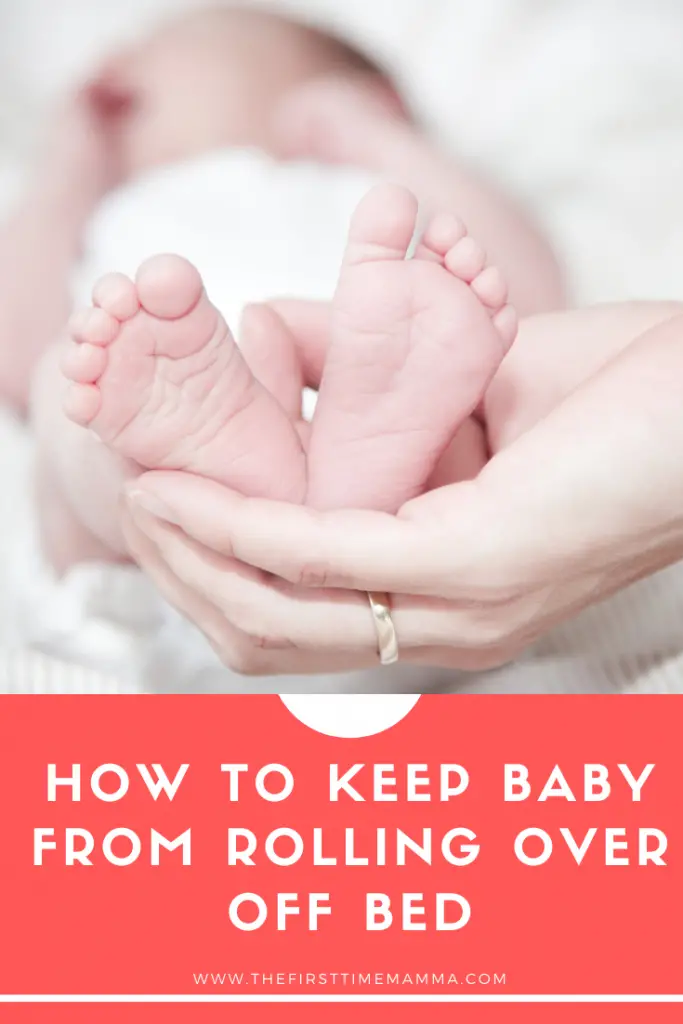It is so exciting and fun to watch your little one grow and develop right before your eyes. Rolling over from back to stomach is one of the first crucial and major mobility milestones of a baby’s first year. While it’s all fun and game when the baby does it during playtime but it can get pretty frustrating and scary during the night when they roll over in their sleep and wake up crying in the middle of the night. The American Academy of Pediatrics (AAP) recommends putting babies to sleep on their back without any pillow or blankets in the crib during their first year to reduce the risk of Sudden Infant Death Syndrome (SIDS).
Hey! By the way… any links on this page that lead to products on Amazon are affiliate links and I earn a commission if you make a purchase. Thanks in advance – I really appreciate it! .
Once the babies start rolling over, it is actually considered safe for them to do so even during naps and sleep as long as you have taken some precautionary measures. As soon as babies learn to roll over and have a little control over their tiny bodies, they will practice it again and again in order to move. A playpen or crib is a perfect and safe place for them to practice their newly acquired skill. The reason rolling over happens during naps and sleep as well is that like adults, babies also want to get into a position they find comfortable now that they have bit control over their body. Sometimes, it’s hard to know how to keep baby from rolling over in crib without rolling over.
So, to solve this problem, below are tips to keep baby from rolling over in crib.
#1. The first thing to do when the baby rolls over is to make sure it is not creating a sleeping hazard. If you used to swaddle your baby during sleep, then you should stop swaddling at once. A swaddled baby should never be placed down to sleep on their stomach. Also, all that moving around will no doubt tug at the swaddling blanket which may come loose and thus create a major risk for suffocation. Instead of swaddling, invest in a sleep sack now. This will provide a cozy environment for the baby while keeping their hands mostly free.
#2. Make sure your little one’s crib or playpen is safe from all the things that can pose a potential suffocation threat. This means that you get rid of pillows, blankets, or toys now that the entire area of the bed has become accessible for the baby. Also, use fitted sheets for the mattress. Keep their face and head uncovered.
#3. Pediatricians recommend putting the baby to sleep on their back and let them stay asleep if they have learned to roll from back to stomach and to the back again. However, if the baby has not learned two ways of rolling then, most parents find that rolling the baby back onto their back, will help especially if they wake up crying after rolling over. There is no proper ‘cure’ to it. It is a natural process of growth. So, you can’t really do anything to stop it. Thankfully, this phase is short-lived and your baby will be able to do two ways rolling in about 2-3 weeks. Till then many parents will try this temporary way out.
#4. Give them lots of tummy time during the day so they can develop their back and neck muscles quickly which will enable them to learn to roll over to their back as soon as possible.
#5. If your baby wakes up in the middle of the night from rolling and can’t roll onto his back yet, then you can also consider buying a positioned swaddle or sleeper that helps you in keeping baby position on to their backs. Though sometimes it may also make babies frustrated because they can’t roll in their crib anymore which can create different sleeping troubles.
#6. Don’t be anxious now that your little one has developed the strength to roll over; they have also learned to sense the trouble when sleeping. This means the baby is less likely to be stuck in a position that will compromise their breathing. Also after six months, the risk of SIDS starts to decline though it is still recommended to put the baby to sleep on their back in the crib but do not worry when they flip the moment you put them to sleep on their back.
#7. If your baby is using the bassinet, be sure to move them to a crib, cot or playpen once they show signs of rolling over.
#8. If you are really worried about your baby turning over in sleep, then you can try extending one of their arms and see if this helps you to keep them from rolling.
#9. Avoid using a positioning pillow to keep them asleep on their back as it can become a cause of a suffocation hazard for your munchkin.
Learn to keep baby from rolling over in crib
Do not worry too much as this phase is quite short-lived. Your baby will lose interest in rolling over soon and will stop interrupting their sleep with this new skill in a few weeks. Sleep problems due to this milestone are usually short-lived and will get resolved quickly. If your baby is still at the beginning stage of rolling over, then ask your partner to pitch in and help baby sleep so you can catch up on the sleep you’re losing. Once your baby is strong enough to master the art of rolling over, then you don’t need to be worried about them rolling in sleep.
Generally, if they have learned that, then they are already past the riskiest stage of SIDS. Since they have learned how to return to their back from the stomach, you do not need to get worried about them rolling over anymore. Just relax, go back to sleep and enjoy this new milestone as much as you can by engaging the baby with tummy time and toys on a baby gym during the day. Also, be sure to make and capture these adorable moments.


